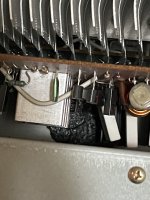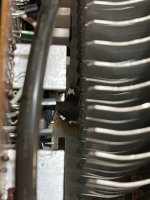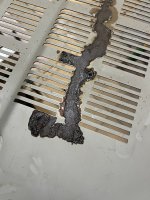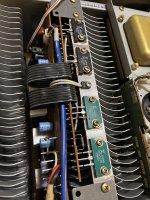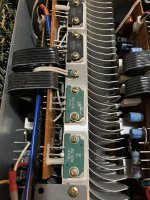Hey all! Apologies if this isn't the correct area for this!
I recently picked up a vintage Luxman integrated amp for super cheap in hopes of doing some DIY repairs to it! Upon further inspection, the left channel seems to not be working whatsoever.
I believe whatever this black gunk is, is likely the culprit... (Apologies for the pics being kinda bad) It seems like the source of the gunk is near the left channel board, which isn't surprising.
Does this gunk look like it came from a burst cap? Or could it be something worse? I haven't been able to take it apart yet sadly.
Also, from the third pic, are these ceramic caps about to go? Can't say I've ever seen those bulge before....
Thanks for any insight!
I recently picked up a vintage Luxman integrated amp for super cheap in hopes of doing some DIY repairs to it! Upon further inspection, the left channel seems to not be working whatsoever.
I believe whatever this black gunk is, is likely the culprit... (Apologies for the pics being kinda bad) It seems like the source of the gunk is near the left channel board, which isn't surprising.
Does this gunk look like it came from a burst cap? Or could it be something worse? I haven't been able to take it apart yet sadly.
Also, from the third pic, are these ceramic caps about to go? Can't say I've ever seen those bulge before....
Thanks for any insight!
Attachments
Not sure about your gunk but it certainly didn´t come from those caps.
And Electrolytics are filled with water + a kind of salt, so leaks leave white dust/crystals behind, and if on metal: corrosion, similar to that from a burst battery.
Those caps are fine.
Imagine you grab one of them by the legs and dip it in a can of paint, you will have a drop form on the bottom, which when soldered to the board will be the top again.
You are seeing that.
And Electrolytics are filled with water + a kind of salt, so leaks leave white dust/crystals behind, and if on metal: corrosion, similar to that from a burst battery.
Those caps are fine.
Imagine you grab one of them by the legs and dip it in a can of paint, you will have a drop form on the bottom, which when soldered to the board will be the top again.
You are seeing that.
The black gunk looks like glue they use to hold parts in place. It's often used on large electrolytic caps so people think it is something leaking from them.
Those green capacitors are not ceramic, they are polyester film.
Those green capacitors are not ceramic, they are polyester film.
Also while opening up the bottom I found the root of my problem with the left channel, nearly all the transistors pins are damaged (maybe from a hard hit to the bottom?)
This should be an easy fix just soldering them back together correct? Or is there a better way to go about it to help with longevity/rigidity?
Very much hoping I don’t need to replace these transistors as it’s just the pins that are damaged
First pic is the faulty left channel while the right is the functional right channel, clear as day what the issue is!
This should be an easy fix just soldering them back together correct? Or is there a better way to go about it to help with longevity/rigidity?
Very much hoping I don’t need to replace these transistors as it’s just the pins that are damaged
First pic is the faulty left channel while the right is the functional right channel, clear as day what the issue is!
Attachments
looks like the leads are cut with cutting pliers. If with hard hit the leads would have broken clean (or bent) but the cut is triangle in shape.Also while opening up the bottom I found the root of my problem with the left channel, nearly all the transistors pins are damaged (maybe from a hard hit to the bottom?)
regds
I believe those transistor leads were cut so they could be tested "out of circuit." They are probably bad which would explain why you got the unit for cheap.
And I wouldn't get too aggressive with cleaning up the "black gunk" because it is doing no harm, and cleaning could lead to unintentional harm.
Mike
And I wouldn't get too aggressive with cleaning up the "black gunk" because it is doing no harm, and cleaning could lead to unintentional harm.
Mike
@Michael Bean could I do much harm soldering them back together and seeing what happens?
Thankfully looks like $60 for two sets of these which isn’t the worst case scenario haha
https://www.ebay.com/itm/401500432098
Thankfully looks like $60 for two sets of these which isn’t the worst case scenario haha
https://www.ebay.com/itm/401500432098
Do NOT waste your Money bying semiconductors from EEbah and Even Worse from an Chinese Shop!!@Michael Bean could I do much harm soldering them back together and seeing what happens?
Thankfully looks like $60 for two sets of these which isn’t the worst case scenario haha
https://www.ebay.com/itm/401500432098
Look at Google for reliable supliers, or a substitute (e.g. 2sc2565 .....) . Ask the forummembers to sell.
Good Lück, the amp is worth it
Ingo
Damm thesaurus
Those look like the old Fujitsu ring emitter transistors. Harder to fake, as the package is rather special. It's also a good sign that the two sexes of parts are different colors. That would generally be too much trouble for a counterfeiter. Having said that, the China address of the seller gives cause for concern. I always screen my search hits on Ebay with "closest first", so all the China vendors are on the bottom.
Yeah buying from Ebay isn't ideal and even less so with the buyer in China, but at least this one has a ton of reviews I guess. I'll for sure look elsewhere but might be a bit SOL, good to have a last resort even if it involves rolling the dice lmao
Thanks @ingo50 & @wrenchone
Anyone have any experience biasing these as well? I've been reading online that it's a pretty big pain
Thanks @ingo50 & @wrenchone
Anyone have any experience biasing these as well? I've been reading online that it's a pretty big pain
Gotta agree those leads were clearly cut. The black goo on the bottom looks like the remains of foam padding. It either does two things after many years. Turn into black goo or powder.
That sounds reasonable. I thought at first that the black crud looked rather like fluorescent ballast juice, but I don't thinks there's anything potted on the amp that could leak like that.
Last edited:
Isn't it spilled coffee or chocolate? I would clean it for sure.
Which type Luxman is this? It helps to be specific on technical fora as many immediately start looking for schematics to help you out.
It would be good practice finding the schematics and measure all the voltages in the defective channel. It could very well be that more transistors are goners. If not then you are a lucky guy. Then find new original (NO Ebay) power transistors and it would be best to replace them in both channels.
Which type Luxman is this? It helps to be specific on technical fora as many immediately start looking for schematics to help you out.
It would be good practice finding the schematics and measure all the voltages in the defective channel. It could very well be that more transistors are goners. If not then you are a lucky guy. Then find new original (NO Ebay) power transistors and it would be best to replace them in both channels.
There's little harm in cleaning the goo off the chassis panel. That could be a test bed to figure out which solvent can clean the stuff. Be careful with solvents on the PCB, though. Some components (polystyrene caps, for example) dissolve when exposed to solvents. Solvents can also carry dissolved crud into places where you don't want it; into relays for example.
You could carefully use a cotton swab dipped in solvent to remove the goo from the board. Just don't stick it in your ear after... 🙂
But unless there's signs of corrosion from the goo, I'd be in favour of leaving it alone.
Tom
You could carefully use a cotton swab dipped in solvent to remove the goo from the board. Just don't stick it in your ear after... 🙂
But unless there's signs of corrosion from the goo, I'd be in favour of leaving it alone.
Tom
Put the bottom cover in the sink and clean it with water, a mild detergent and a brush. It is not made of paper.
Maintenance normally is cleaning and checking. With old stuff the bonus is that it won't smell like old electronics when cleaned.
Maintenance normally is cleaning and checking. With old stuff the bonus is that it won't smell like old electronics when cleaned.
Last edited:
Output devices in commercial gear do not die alone. Direct-coupled transistor amplifiers are highly inter-related. Sometimes all-but-one of the devices, all the way back to the input, are also blown. Partial replacement and re-trying makes an ever-growing pile of dead parts.$60 for two sets of these
This was tolerable on the first Dynacos with just six transistors, but got tedious on later more elaborate amps.
Therefor IC amplifiers 🙂 CanPeng, you can still install a class D module in that Luxman. Easier, less work and for some very important: cheaper.
This one is great, can be found cheaper elsewhere:
https://www.audiophonics.fr/fr/modu...21-40-class-d-ma12070-160w-4-ohm-p-14732.html
Or go off the beaten track and convert to a mono listener. Zen.
This one is great, can be found cheaper elsewhere:
https://www.audiophonics.fr/fr/modu...21-40-class-d-ma12070-160w-4-ohm-p-14732.html
Or go off the beaten track and convert to a mono listener. Zen.
- Home
- Amplifiers
- Solid State
- What is this black gunk?
